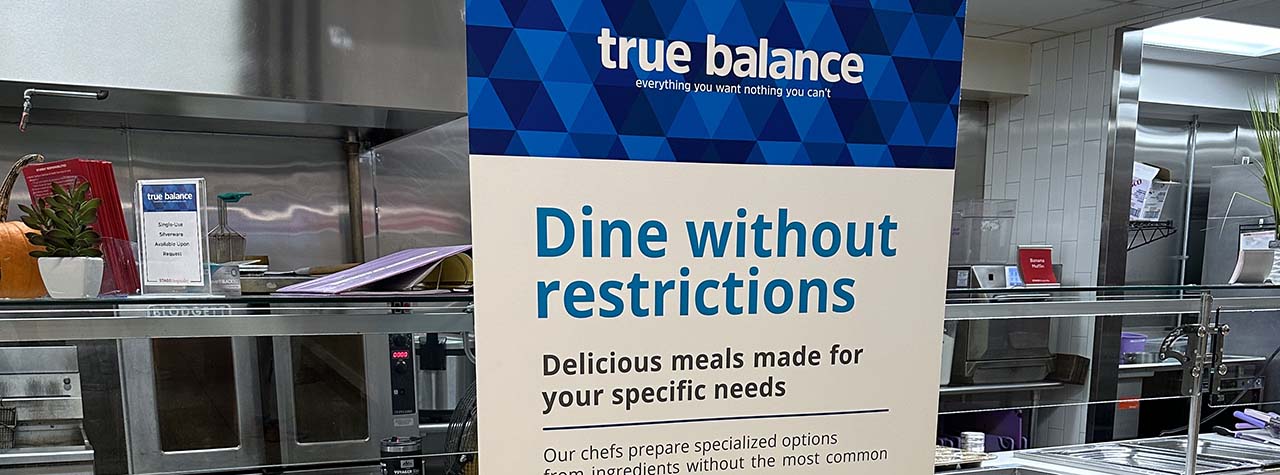Janine Flannery, founder of The Allergy Aspect is touring college campuses with her son who has multiple, severe food allergies and EoE. She shares important takeaways from their tours — a crash course — that will help you know what to look for and what to ask to understand if a college can safely fuel your student. Learn more…
I find that figuring out if your kid with food allergies will be able to safely eat at a college is like trying to read a crystal ball.
We’ve been busily touring college campuses these past months, taking advantage of every school break and weekend. Beyond all the usual aspects of college tours, and connecting with the disability offices, we’re keen to learn how each school we visit feeds students with dietary restrictions.
Our son deals with a double digit number of allergens and EoE trigger foods (there are so many I keep a list on my phone) and has a long history of anaphylaxis. Understandably, researching safe dining options on campuses is a top priority for us.
Here are things we’ve learned from our deep dives into dining services at different colleges. You may want to dig in and do some due diligence on them as you look at schools with your teen:

1. Not all dining hall allergy-friendly food stations are created equal.
For example, though fish is a Top 9 allergen, it’s been popping-up in allergy-friendly food stations at different schools. I understand that schools are trying to diversify protein options for students. But? (and fish just happens to be one of my son’s many allergens…)
2. Not all dining halls define the term ‘allergy-friendly’ the same way.
Be sure to confirm what the definition of ‘allergy-friendly’ means at each school. It can vary widely – at some it can mean nut-free and gluten-free; at others it can mean top 8 (not 9!) free.
3. Confirm the hours the allergy-friendly dining areas are open.
Some allergy-friendly stations may not serve breakfast, while others might close for the weekend, or only open for specific, limited hours during the day.
4. Consider the variety of safe foods rotated at the allergy stations.
If your student’s best option will be eating a plain sautéed chicken breast every day for every meal, will he/she be ok with that? If they can even eat chicken? A friend’s son with multiple food allergies ate Congee (rice soup/porridge) for breakfast everyday for four years because that was the only safe, fast option for him at his small college’s single dining hall.
5. Consider the location of the allergy-friendly dining options on campus.
Location-location-location is key. Is there more than one station? Is at least one close to dorms and classes? Or, will your student possibly have to trek to the other end of campus for meals?
6. Find out if food-allergic students can text-a-chef to pre-order meals.
Dig into how this would work for your student. Where would the meal have to be picked-up? Would it be a take-out style meal or served in the dining hall? This may not be the first option dining services want to offer, or it may be a standard part of their restricted diet services. You won’t know unless you ask.
7. A good to know — find out if there’s stock epinephrine in the dining halls.
Some schools provide stock epinephrine in dining halls and have on-site staff trained to recognize anaphylaxis and administer the medication. This is not a substitute, though, for your student carrying epinephrine everywhere all the time. Practice and reinforce good food allergy habits at home while your teen still lives with you.
8. Dorms sometimes have shared kitchens for student use.
On the last college tour I attended with my son, our guide showed us a kitchen for students in one dorm. That one kitchen serves 50 students! (I’m sure you can picture its condition.) If your student is game to use a communal kitchen, consider equipping them with a bin stocked with cooking supplies, utensils, dish detergent and sponges, paper towels and wipes. It can live under their bed within easy reach. This could be a lifesaver if the dining hall lets them down or they’re in desperate need of a midnight snack.
9. Actually eat in the dining hall. Give the allergy-friendly station a test run.
Nothing beats the firsthand intelligence you will gather from a real-time experience with a dining hall’s allergy-station. Talk with the chef or dining staff while you’re at it to evaluate what may be safe to eat and learn how things work behind the scenes. Look for transparency from these conversations.
******
As we anticipate this next stage of independence for my son, we’re scrambling to transfer know-how, like 100% recognizing the telltale signs of an allergic reaction that can vary and basic cooking skills. We’re constantly trying to reinforce good food allergy habits like reading labels, carrying epinephrine, and self-advocating. It’s coming along, but it’s still a work in process
With my allergic son completing his junior year of high school, our runway to prepare him for college independence shortens with every passing day, I admit I feel a sense of urgency. The clock is ticking.
But I equally feel a sense of hope that if we continue to do the food allergy parent thing well, continue to teach him and empower him, he’ll be ready and able to soar safely and confidently in college and beyond.
(Though I’m secretly hoping he lands at a college that’s not too too far away from home!)

*(Don’t miss Janine’s article about her family’s OIT experience and their trip to France — what happened, what they learned.)
Helpful Resources for Your College Search
FAACT (Food Allergy & Anaphylaxis Connection Team) has a great College Resource Center with a wide variety of tools to help food allergic college bound students and their families prepare for safe college living.
This free app — findERnow — locates the closest ER to you in the event you’re having a medical emergency and need help. With each college we visit, I do a search to be aware of the local availability of emergency services. Available for Apple and Android devices.
The Spokin app – also free – has great college resources and reviews from food allergic college students themselves. It’s very helpful to hear of first-hand personal experiences from students actually living and eating (safely) on campuses around the country. Spokin is also an all-around great resource for all things allergy living.
FARE usually holds its annual Food Allergy Summit in the fall. I attended last fall and listened in at every session that offered tips on evaluating colleges and their dining services. Consider attending if you can, even if your teen is uninterested, to expand your knowledge base and connect with other parents on a similar quest for knowledge. Keep an eye out for details on this year’s Summit at FARE’s website.
 |
Janine Flannery’s OIT to EOE journey inspires her to help others live creatively and find balance in the simple, every day. |
| About the Author: Janine Flannery is the creator and founder of theallergyaspect.com, an online resource for anyone living with or caring for someone with food limitations due to food allergies and eosinophilic esophagitis (EOE). Managing these chronic illnesses for her son for over a decade, Janine’s passionate about connecting with others living with similar challenges and sharing how her family lives their life fully. With a brand management background in the natural foods industry, she brings unique perspectives with experience both as a food allergic consumer and a food industry professional. Feel free to reach out with any questions at theallergyaspect.com or visit her on Instagram (@theallergyaspect) and Facebook (@TheAllergyAspect.) | |
Image: Courtesy of The Allergy Aspect


